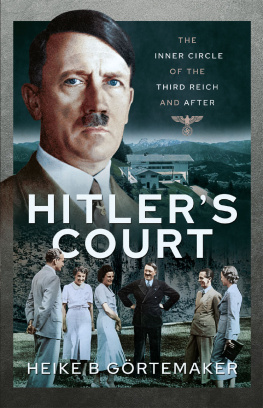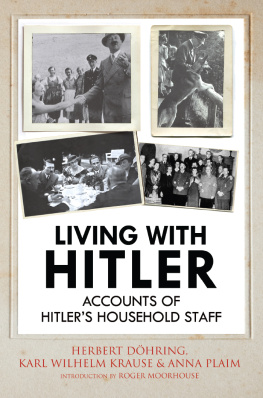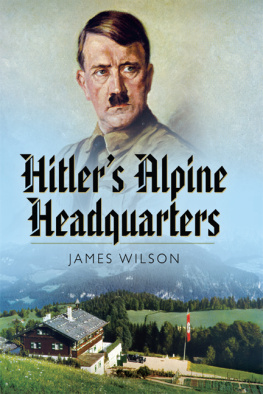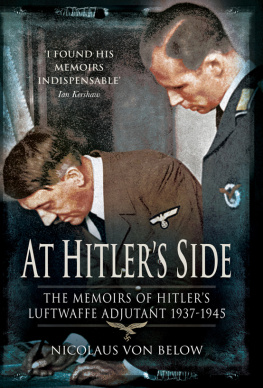HITLER AT HOME
HITLER AT HOME
DESPINA STRATIGAKOS

Published with assistance from the Graham Foundation for Advanced Studies in the Fine Arts.
Copyright 2015 by Despina Stratigakos. All rights reserved. This book may not be reproduced, in whole or in part, including illustrations, in any form (beyond that copying permitted by Sections 107 and 108 of the U.S. Copyright Law and except by reviewers for the public press), without written permission from the publishers.
yalebooks.com/art
Designed and set in Adobe Garamond type by Lindsey Voskowsky.
Printed in the United States of America by Thomson-Shore, Inc., Dexter, Michigan.
Library of Congress Control Number: 2014953548
ISBN 978-0-300-18381-8
e ISBN 978-0-300-18760-1
A catalogue record for this book is available from the British Library.
This paper meets the requirements of ANSI/NISO Z 39.481992 (Permanence of Paper).
10 9 8 7 6 5 4 3 2 1
Jacket illustrations: (front) Eva Brauns room in the Berghof with framed Hitler portrait (detail of ).
To my mother, who lived it
CONTENTS
ACKNOWLEDGMENTS
Chasing the remnants of Adolf Hitlers domesticity has taken me from Tucson, Arizona, to the Austrian Alps, and along the way I have been met with hospitality and gracious help. Dieter and Margit Umlauf welcomed me into their home and shared their familys history. Charles Turner repeatedly passed along valuable sources. Franz Andrelang gave me access to the sealed personal papers of Gerdy Troost, and Nino Nodia helped me to navigate the immense uncatalogued collection. Richard Reiter offered memories and answered questions about the Obersalzberg. Harald Freundorfer took me through Hitlers Munich apartment building. I thank them all for enabling and enriching my research.
My travels have been generously funded by the Gerda Henkel Foundation, the Graham Foundation for Advanced Studies in the Fine Arts, the German Academic Exchange Service ( DAAD ), and the Baldy Center for Law and Social Policy of the University at Buffalo. As a fellow at Rice Universitys Humanities Research Center, I found a home-away-from-home where I could engage with other scholars and undertake research with the thoughtful assistance of the centers staff. The Wolfsonian FIU Museum in Miami Beach awarded me a fellowship to study its Third Reich collections, aided by its ever-helpful staff. I am deeply grateful to all these institutions for supporting my research. The University at Buffalo has been equally generous in granting me an extended leave that made the research and writing of this book possible, and I am thankful in particular to Robert Shibley, Omar Khan, and William McDonnell for making it happen. I am also indebted to Burcu Dogramaci of the Institute for Art History at the Ludwig Maximilian University of Munich for being the ideal academic host and partner in Germany.
In progressing from the initial idea to the finished manuscript, I have benefited from the sagacity and knowledge of many colleagues, who provided encouragement and feedback at critical junctures. I would like to thank Leora Auslander, Richard Bessel, Joy Calico, James van Dyke, Sean Franzel, Dianne Harris, Hilde Heynen, Keith Holz, Edina Meyer-Maril, Barbara Miller Lane, Barbara Penner, Leslie Topp, and Rebecca Zorach. David Wellberys DAAD Interdisciplinary Summer Seminar in German Studies at the University of Chicago inspired me to rethink the role of narrative in my project. At Rice University, I thank in particular Peter Caldwell, Christian Emden, Caroline Levander (then-director of the Humanities Research Center), Uwe Steiner, Sarah Whiting, and Lora Wildenthal. In Munich, Christian Fuhrmeister and Iris Lauterbach of the Central Institute for Art History and Michaela Rammert-Gtz of the United Workshops Archive kindly shared their expertise and steered me toward new sources.
On the final leg of revisions and consolidation, help came in doubles. Two expert readers strengthened the manuscript with their insights and immense learning: Karen Fiss of the California College of the Arts and Paul Jaskot of DePaul University. I have been fortunate to work with two wonderful editors: Michelle Komie, whose faith and enthusiasm brought the project to Yale University Press, and Katherine Boller, whose skill and understanding made for smooth sailing to the end. I am also grateful for the keen eyes of Martina Kammer and Laura Hensley, who, from their respective German- and English-language standpoints, identified and subdued the occasional rogue word. Heidi Downey and Mary Mayer deftly guided this book through the production process, and the Graham Foundation once again lent its support with a publication grant.
And, finally, what would a journey be without postcards and shared memories? To my family and friends for keeping the mail, love, and laughter flowingmany times, over and over, thank you.
INTRODUCTION
The Power of Home
As Allied troops moved into Bavaria at the end of World War II in Europe, soldiers and journalists sought out the places where Adolf Hitler had lived in an attempt to understand the man who had plagued and terrorized humanity. U.S. Sergeant Harry Sions, writing for Yank magazine, peered into Hitlers bathroom cabinet at the Berghof, the dictators mountain home, and pondered the bottles of castor oil and mouthwash he found there. Vogue correspondent Lee Miller, staying at Hitlers Munich apartment, rummaged through his closets and noted the monogrammed linen and silver.
Our domestic spaces and possessions, we believe, reveal our inner selves, and the deeper the closet or cabinet, the greater the secrets. Hitlers homes had not only the conventional nooks and crannies but also whole underground bunkers and passageways, and reporters (and subsequently tourists) searched them thoroughly for clues. There were rumors of torture chambers as well as overflowing treasuries, and some went in search more for buried riches than for hidden truths. But journalists and sightseers were also drawn to those spaces precisely because Hitlers domesticity had been so highly visible during the Third Reich. Especially in his mountain home, where he had often been photographed, Hitlers private life had been carefully orchestrated for public consumption, with the images and stories broadly distributed at home and abroad. Millions of readers felt that they knew Hitler the man through this domestic performance, and when Allied soldiers and reporters arrived in Germany, they were drawn to the places where his ghost seemed to linger.
This book follows in the footsteps of these domestic explorers but seeks a different sort of understanding. The first major postwar biography of Hitler, published by Alan Bullock in 1952, dismissed the meaningfulness of the Fhrers private life as meager and uninteresting at the best of times. A wholly different attitude characterized the tell-all books that emerged in subsequent decades, which scoured Hitlers body, family past, and relationships to men and women for anomalies on a personal scale that could somehow explain a cosmic catastrophe. Hitler at Home acknowledges the importance of the private realm without seeking to be a biography told through architecture. Instead, I am interested in how Hitler chose to present his domestic self to the public, and in the designers, photographers, and journalists who constructed and conveyed the image to German- and English-language audiences, who were all too eager to consume it.
By the mid-1930s, it was all but impossible to avoid images and stories about the domestic Hitler. The topic was not only covered by the German media with greatindeed, almost obsessivezeal, but it was also embraced by an English-language press serving a global audience, from London to Sydney, Toronto to Phoenix, and Bombay to Shanghai. In Germany, a market quickly emerged for popular consumer goods bearing images of the Fhrers home or of its owner at leisure on the Obersalzberg. One could decorate with a Hitler housethemed porcelain plate or embroidered throw pillow, save pennies in a replica coin bank, play with a toy model, send a postcard showing Hitler feeding deer on his terrace, or buy one of the many photographic albums that documented his life at home, from the dictator entertaining children to hiking with his dog. For a time, Hitlers mountain retreat was arguably the most famous house in the world.
Next page








